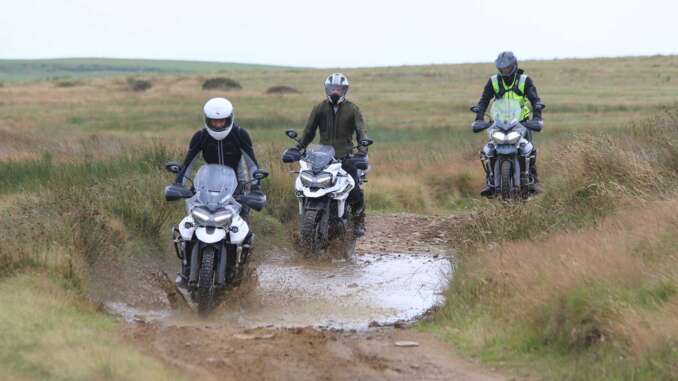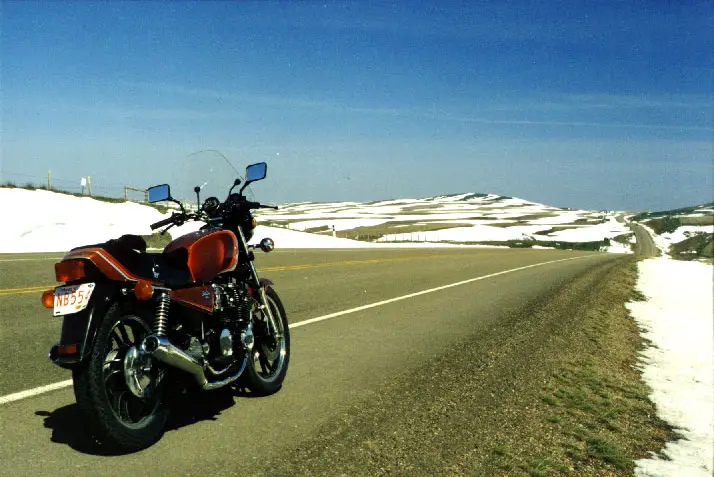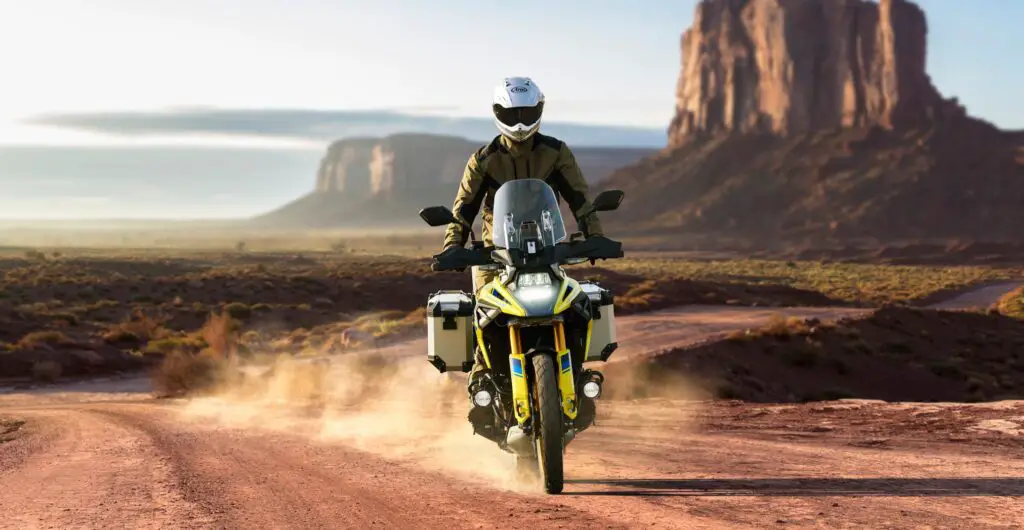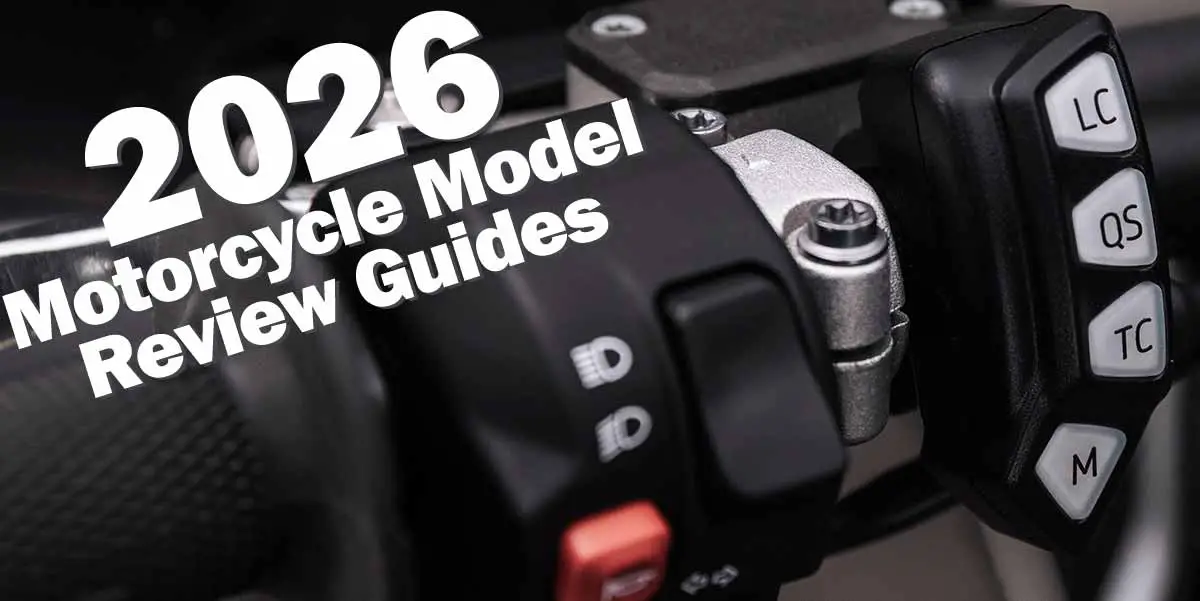
Safety & Roadcraft: Weather Riding Guide
From rain to storms, every weather condition changes the ride. Total Motorcycle’s Weather Riding Guide guide covers 10 common challenges – and how to adapt safely to each.
Riding in Rain
The Challenge: Reduced traction, longer stopping distances, poor visibility, and slippery surfaces (paint, manhole covers, leaves).
🚫 Myth‑busting: “Rain makes roads too slippery to ride safely.”
Reality: With smooth inputs, proper gear, and awareness, rain riding is manageable and builds skill.
✅ Practical Strategies
- Gear: Waterproof gloves, jacket, pants, and anti‑fog visor
- Technique: Smooth throttle, brake, and steering inputs
- Positioning: Ride in car tire tracks where water is displaced
- Braking: Use more rear brake than usual to stabilize
- Visibility: Increase following distance, use high‑viz gear
🛠️ Practice Drill
On a wet but empty lot, practice gentle braking from 20 km/h. Focus on smooth front brake squeeze and light rear brake.
Note the longer stopping distance and adjust your following space accordingly.
| Rain Hazard | Risk Level | Best Response |
|---|---|---|
| Painted lines | High | Avoid braking/leaning on them |
| Manhole covers | High | Cross upright, no throttle/brake |
| Puddles | Medium | Slow down, avoid hydroplaning |
| First 15 min of rain | Very High | Oil rises, traction worst |
Riding in Wind
The Challenge: Crosswinds push the bike sideways, gusts unsettle balance, and headwinds reduce acceleration. Trucks and open plains amplify the effect.
🚫 Myth‑busting: “Lean harder into the wind to fight it.”
Reality: Over‑leaning tires you out and reduces control. The key is relaxed posture, lane positioning, and anticipating gusts.
✅ Practical Strategies
- Posture: Stay loose on the bars, grip the tank with knees
- Lane Position: In crosswinds, ride slightly upwind in your lane to allow drift room
- Passing Trucks: Expect a push/pull effect – lean slightly into it, then relax after clearing
- Speed: Reduce speed in strong gusts for stability
- Group Riding: Stagger formation, increase spacing
🛠️ Practice Drill
On a breezy day in a safe area, ride a straight stretch at moderate speed. Practice relaxing your arms and steering with light bar inputs while gripping the tank with your knees.
Focus on letting the bike move slightly under you instead of fighting every gust.
| Wind Type | Effect | Best Response |
|---|---|---|
| Crosswind | Pushes bike sideways | Shift lane position upwind, stay loose |
| Headwind | Reduces acceleration | Downshift, maintain steady throttle |
| Tailwind | Increases speed unexpectedly | Cover brakes, adjust following distance |
| Truck wake | Push/pull turbulence | Anticipate, lean slightly, relax after pass |
Riding in Cold
The Challenge: Reduced body warmth slows reaction time, stiffens muscles, fogs visors, and lowers tire traction until warmed. Hypothermia risk rises on long rides.
🚫 Myth‑busting: “If I’m tough, I don’t need special gear for cold.”
Reality: Cold stress reduces focus and reaction time. Proper layering and prep are safety essentials, not luxuries.
✅ Practical Strategies
- Layering: Base (moisture‑wicking), mid (insulating fleece/wool), outer (windproof/waterproof)
- Hands & Feet: Heated grips, insulated gloves, thermal socks, waterproof boots
- Visor: Anti‑fog insert or Pinlock, crack visor slightly at stops
- Tires: Ride gently for 10–15 minutes to warm rubber before leaning hard
- Breaks: Stop every 45–60 minutes to warm up and check alertness
🛠️ Practice Drill
On a cold day, start with a 15‑minute loop at moderate speed. Focus on smooth throttle and brake inputs while tires warm.
Practice visor management (cracking open at stops, closing at speed) to prevent fogging.
| Temperature | Gear Priority | Riding Adjustment |
|---|---|---|
| 10–15°C | Light layers, gloves | Gentle warm‑up, normal pace |
| 5–10°C | Thermal base, windproof jacket | Longer warm‑up, shorter rides |
| 0–5°C | Heated grips, insulated boots | Extra caution, avoid long highway runs |
| Below 0°C | Full heated gear, balaclava | Consider postponing ride – ice risk |
Riding in Heat
The Challenge: Dehydration, fatigue, heatstroke risk, and reduced concentration. Hot pavement also affects tire grip.
🚫 Myth‑busting: “Less gear keeps me cooler.”
Reality: Mesh or ventilated gear protects from sunburn, dehydration, and road rash while allowing airflow.
✅ Practical Strategies
- Hydrate before and during rides – sip every 20 minutes
- Wear ventilated mesh gear or moisture‑wicking base layers
- Take shade breaks every hour
- Ride earlier in the morning or later in the evening
🛠️ Practice Drill
On a hot day, ride a short loop and monitor your focus. If concentration fades, stop and hydrate. Train yourself to recognize early fatigue signs.
| Heat Index | Risk | Adjustment |
|---|---|---|
| 30–34°C | Moderate | Hydrate, ventilated gear |
| 35–39°C | High | Short rides, frequent breaks |
| 40°C+ | Extreme | Postpone ride if possible |
Riding in Fog
The Challenge: Reduced visibility, moisture on visor, and difficulty judging distance.
🚫 Myth‑busting: “High beams help in fog.”
Reality: High beams reflect off fog and reduce visibility. Use low beams or fog lights.
✅ Practical Strategies
- Use low beam headlights and reflective gear
- Reduce speed and increase following distance
- Keep visor clean and crack it slightly to reduce fogging
🛠️ Practice Drill
In light fog or mist, practice riding at reduced speed with exaggerated scanning. Focus on lane markers as guides.
| Visibility | Adjustment |
|---|---|
| 200 m+ | Normal pace with caution |
| 100–200 m | Reduce speed, increase spacing |
| <100 m | Consider delaying ride |
Riding at Night
The Challenge: Reduced visibility, glare from headlights, and increased wildlife activity.
🚫 Myth‑busting: “If I can see, others can see me.”
Reality: Riders are less visible at night. High‑viz gear and auxiliary lights improve conspicuity.
✅ Practical Strategies
- Wear reflective gear and add auxiliary lighting
- Reduce speed and scan further ahead
- Avoid looking directly at oncoming headlights
🛠️ Practice Drill
On a quiet road, practice scanning 12 seconds ahead and identifying hazards earlier than in daylight.
| Condition | Adjustment |
|---|---|
| Urban | Watch for pedestrians, intersections |
| Rural | Scan for wildlife, use high beams when safe |
Riding in Snow & Ice
The Challenge: Extremely low traction, hidden ice patches, and cold stress.
🚫 Myth‑busting: “Knobby tires make snow safe.”
Reality: Even with aggressive tread, motorcycles are unstable on ice. Avoid unless absolutely necessary.
✅ Practical Strategies
- Postpone rides if snow/ice is present
- If unavoidable: ride upright, avoid lean, and use gentle throttle
- Double following distance
🛠️ Practice Drill
If you must ride in light snow, practice very slow straight‑line starts and stops in a safe lot. Focus on feathering clutch and rear brake only.
| Surface | Risk | Advice |
|---|---|---|
| Dry cold asphalt | Medium | Gentle warm‑up, watch for black ice |
| Snow dusting | High | Ride upright, avoid lean |
| Ice patches | Extreme | Avoid riding |
Riding in Dust or Smoke
The Challenge: Reduced visibility, eye irritation, and inhalation risks. Common near wildfires, deserts, or construction zones.
🚫 Myth‑busting: “A tinted visor is enough.”
Reality: Dust and smoke require sealed eye protection and sometimes a mask/neck gaiter for breathing comfort.
✅ Practical Strategies
- Wear sealed goggles or a full‑face helmet with visor closed
- Use a neck gaiter or mask to reduce inhalation of particles
- Ride with low beams and hazard lights if visibility is poor
- Increase following distance – dust hides brake lights
🛠️ Practice Drill
In a safe, dusty lot (like gravel), practice riding with visor closed and scanning further ahead.
Focus on smooth throttle to avoid kicking up more dust and reducing your own visibility.
| Condition | Risk | Adjustment |
|---|---|---|
| Light dust | Low | Visor down, steady throttle |
| Heavy dust | High | Reduce speed, increase spacing |
| Smoke haze | High | Mask/gaiter, lights on, shorter rides |
| Thick smoke | Extreme | Postpone ride – health risk |
Riding in Extreme Heatwaves
The Challenge: Heatstroke, dehydration, and bike overheating. Pavement temps can exceed 50°C, stressing tires and engines.
🚫 Myth‑busting: “Short rides don’t need hydration.”
Reality: Even 30 minutes in extreme heat can cause dehydration and fatigue.
✅ Practical Strategies
- Hydrate before, during, and after rides – use a hydration pack
- Plan routes with fuel stops and shaded rest areas
- Check coolant and oil levels before riding
- Inspect tires for overheating or softening
🛠️ Practice Drill
On a hot day, ride a short loop and stop every 15 minutes. Practice removing gloves, hydrating, and checking your bike quickly.
Build the habit of proactive breaks before fatigue sets in.
| Heat Level | Body Risk | Bike Risk | Adjustment |
|---|---|---|---|
| 30–35°C | Dehydration | Normal | Hydrate often |
| 35–40°C | Heat exhaustion | Tire softening | Short rides only |
| 40°C+ | Heatstroke risk | Overheating engine | Postpone ride |
Riding in Storms & Lightning
The Challenge: Heavy rain, wind gusts, lightning strikes, and flash flooding. Visibility and traction drop sharply.
🚫 Myth‑busting: “If I keep moving, lightning won’t hit me.”
Reality: Motorcycles offer no lightning protection. Seek shelter immediately if lightning is near.
✅ Practical Strategies
- Check weather radar before rides – avoid storm cells
- If caught: reduce speed, increase following distance, and avoid flooded roads
- Seek shelter under solid structures (not trees or overpasses)
- Wait 30 minutes after last thunder before resuming
🛠️ Practice Drill
In heavy rain (without lightning), practice controlled braking and swerves in a safe lot.
Focus on smoothness and recognizing when traction begins to fade.
| Storm Hazard | Risk | Response |
|---|---|---|
| Heavy rain | High | Slow down, smooth inputs |
| Lightning | Extreme | Stop, seek shelter |
| Flooded roads | Extreme | Never cross – turn back |
| Strong gusts | High | Grip tank, reduce speed |
Mastering the Elements
Quick Reference: 10 Weather Conditions
| Condition | Key Risk | Adjustment |
|---|---|---|
| Rain | Reduced traction, slippery surfaces | Smooth inputs, ride in tire tracks, increase distance |
| Wind | Crosswind drift, truck turbulence | Stay loose, grip tank with knees, adjust lane position |
| Cold | Slower reactions, cold tires | Layer gear, warm tires gently, take frequent breaks |
| Heat | Dehydration, fatigue | Hydrate often, ventilated gear, ride early/late |
| Fog | Low visibility | Use low beams, reduce speed, increase spacing |
| Night | Reduced visibility, glare | Reflective gear, auxiliary lights, scan further ahead |
| Snow/Ice | Extremely low traction | Avoid if possible, ride upright, no lean/brake on ice |
| Dust/Smoke | Visibility, breathing issues | Visor closed, mask/gaiter, lights on, increase spacing |
| Heatwaves | Heatstroke, bike overheating | Hydration pack, shade breaks, check coolant/tires |
| Storms | Lightning, flooding, gusts | Seek shelter, avoid flooded roads, wait out lightning |







